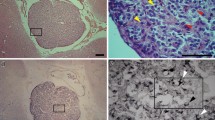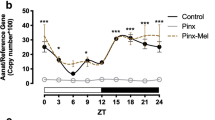Abstract
In vertebrates, melatonin is mainly synthesized from serotonin in the pineal gland. Many reports have documented that melatonin is also synthesized in the extra-pineal tissues, but the synthesis of melatonin in the corpus luteum (CL) of pregnant sows has never been studied. The objectives of this study were to evaluate the expression of melatonin-synthesizing enzymes, arylalkylamine N-acetyltransferase (AANAT) and acetylserotonin O-methyltransferase (ASMT), in the CL of sows during pregnancy and to investigate the synthesis of melatonin in luteal cells. Results showed that AANAT and ASMT were both expressed in the CL of sows during pregnancy, higher levels were observed in the early- and mid-stage CL, and the lowest abundance was found in the regressing CL (later-stage). The immunostaining for AANAT and ASMT was predominantly localized in the large luteal cells of porcine CL during pregnancy. Furthermore, melatonin was synthesized in luteal cells from serotonin in a dose- and time-dependent manner. And the expressions of AANAT and ASMT were upregulated by serotonin in luteal cells. In addition, progesterone (P4) secretion and cell viability were promoted in luteal cells treated with serotonin, and the stimulatory effects were blocked by luzindole (a non-selective MT1 and MT2 antagonist). Finally, the expressions of MT1 and MT2 were augmented by serotonin in luteal cells. In conclusion, this study demonstrates for the first time the developmental expression of AANAT and ASMT in the CL and a local synthesis of melatonin in luteal cells of pregnant sows, and suggests a paracrine and/or autocrine role for melatonin in luteal function.









Similar content being viewed by others
References
Amireault P, Dube F (2005) Serotonin and its antidepressant-sensitive transporter in mouse cumulus–oocyte complexes and early embryo. Biol Reprod 73:358–365
Arosh JA, Banu SK, Chapdelaine P et al (2004) Prostaglandin biosynthesis, transport, and signaling in corpus luteum: a basis for autoregulation of luteal function. Endocrinology 145(5):2551–2560
Axelrod J, Wurtman RJ (1968) Photic and neural control of indoleamine metabolism in the rat pineal gland. Adv Pharmacol 6:157–166
Ayre EA, Pang SF (1994) 2-[125I] Iodomelatonin binding sites in the testis and ovary: putative melatonin receptors in the gonads. Neurosignals 3:71–84
Bódis J, Hartmann G, Tinneberg HR et al (1993) Relationship between the monoamine, progesterone and oestradiol content in follicular fluid of preovulatory graafian follicles after superovulation treatment. Gynecol Obstet Invest 35:232–235
Brzezinski A, Seibel MM, Lynch HJ et al (1987) Melatonin in human preovulatory follicular fluid. J Clin Endocrinol Metab 64:865–867
Brzezinski A, Fibich T, Cohen M et al (1992) Effects of melatonin on progesterone production by human granulosa lutein cells in culture. Fertil Steril 58:526–529
Bubenik GA (2008) Thirty four years since the discovery of gastrointestinal melatonin. J Physiol Pharmacol 59:33col
Carbajo-Pescador S, Martin-Renedo j, Garcia-Palomo A, et al (2009) Changes in the expression of melatonin receptors induced by melatonin treatment in hepatocarcinoma HepG2 cells. J Pineal Res 47:330–338
Chomczynski P, Sacchi N (1987) Single-step method of RNA isolation by acid guanidinium thiocyanate-phenol-chloroform extraction. Anal Biochem 16:156–159
Drazen DL, Bilu D, Bilbo SD et al (2001) Melatonin enhancement of splenocyte proliferation is attenuated by luzindole, a melatonin receptor antagonist. Am J Physiol Regul Integr Comp Physiol 5:R1476-1482
Dubocovich ML, Markowska M (2005) Functional MT1 and MT2 melatonin receptors in mammals. Endocrine 27:101–110
Ekmekcioglu C (2006) Melatonin receptors in humans: biological role and clinical relevance. Biomed Pharmacother 60:97–108
Eva K, Michael I (2001) Melatonin modulation of lymphocyte proliferation and Th1rTh2 cytokine expression. J Neuroimmunol 117:51–57
Faillace MP, Cutrera R, Sarmiento MI et al (1995) Evidence for local synthesis of melatonin in golden hamster retina. NeuroReport 6(15):2093–2095
Ganguly K, Sharma AV, Reiter RJ et al (2010) Melatonin promotes angiogenesis during protection and healing of indomethacin-induced gastric ulcer: role of matrix metaloproteinase-2. J Pineal Res 49:130–140
Gilad E, Matzkin H, Zisapel N (1997) Interplay between sex steroids and melatonin in regulation of human benign prostate epithelial cell growth. J Clin Endocrinol Metabol 82:2535–3241
Itoh MT, Ishizuka B, Kuribayashi Y et al (1999) Melatonin, its precursors, and synthesizing enzyme activities in the human ovary. Mol Hum Reprod 5(5):402n, i
Kojima T, Mochizuki C, Mitaka T et al (1997) Effects of melatonin on proliferation, oxidative stress and Cx32 gap junction protein expression in primary cultures of adult rat hepatocytes. Cell Struct Funct 22:347–356
Lincoln GA (1992) Administration of melatonin into the mediobasal hypothalamus as a continuous or intermittent signal affects the secretion of follicle stimulating hormone and prolactin in the ram. J Pineal Res 12:135–144
Malpaux B, Migaud M, Tricoire H et al (2001) Biology of mammalian photoperiodism and the critical role of the pineal gland and melatonin. J Biol Rhythms 16:336–347
Nakade O, Koyama H, Ariji H et al (1999) Melatonin stimulates proliferation and type I collagen synthesis in human bone cells in vitro. J Pineal Res 27:106–111
Olcese JM (2020) Melatonin and female reproduction: an expanding universe. Front Endocrinol 6:1–10
Pandi-Perumal SR, Trakht I, Srinivasan V et al (2008) Physiological effects of melatonin: role of melatonin receptors and signal transduction pathways. Prog Neurobiol 85:335–353
Pedreros M, Ratto M, Guerra M (2011) Expression of functional melatonin MT1 receptors in equine luteal cells: in vitro effects of melatonin on progesterone secretion. Reprod Fert Develop 23:417–423
Pitzel L, Lüdemann S, Wuttke W (2000) Secretion and gene expression of metalloproteinases and gene expression of their inhibitors in porcine corpora lutea at different stages of the luteal phase. Biol Reprod 62:1121–1127
Reiter RJ, Sharma R (2021) Central and peripheral actions of melatonin on reproduction in seasonal and continuous breeding mammals. Gen Comp Endocr 300:1–13
Reiter RJ (1991) Pineal melatonin: cell biology of its synthesis and of its physiological interactions. Endocr Rev 12:151–180
Reiter RJ (1980) The pineal and its hormones in the control of reproduction in mammals. Endocr Rev 1:109–131
Reppert SM, Weaver DR, Ebisawa T (1994) Cloning and characterization of a mammalian melatonin receptor that mediates reproductive and circadian responses. Neuron 13:1177–1185
Reppert SM, Godson C, Mahle CD et al (1995) Molecular characterization of a second melatonin receptor expressed in human retina and brain: the Mel1b melatonin receptor. Proc Natl Acad Sci USA 92:8734–8738
Richards JS (2001) Perspective: the ovarian follicle—a perspective in 2001. Endocrinology 142:2184–2193
Sainz RM, Mayo JC, Tan DX et al (2003) Antioxdant activity of melatonin in Chinese hamster ovarian cells: changes in cellular proliferation and differentiation. Biochem Biophys Res Commun 302:625–634
Sakaguchi K, Itoh MT, Takahashi N et al (2013) The rat oocyte synthesizes melatonin. Reprod Fert Develop 25(4):674–682
Schmittgen TD, Zakrajsek BA (2000) Effect of experimental treatment on housekeeping gene expression: validation by real-time, quantitative RT-PCR. J Biochem Biophys Methods 46:69–81
Slominski A, Pisarchik A, Semak I et al (2002) Serotoninergic and melatoninergic systems are fully expressed in human skin. Faseb J 16(8):896–898
Slominski A, Tobin DJ, Zmijewski MA et al (2008) Melatonin in the skin: synthesis, metabolism and functions. Trends Endocrinol Metab 19:17–24
Slominski RM, Reiter RJ, Schlabritz-Loutsevitch N et al (2012) Melatonin membrane receptors in peripheral tissues: distribution and functions. Mol Cell Endocrinol 351:152–166
Soares JM, Masana MI, Erşahin C et al (2003) Functional melatonin receptors in rat ovaries at various stages of the oestrous cycle. J Pharmacol Exp Ther 306:694–702
Tamura H, Nakamura Y, Takiguchi S et al (1998) Melatonin directly suppresses steroid production by preovulatory follicles in the cyclic hamster. J Pineal Res 25:135–141
Webley GE, Hearn JP (1987) Local production of progesterone by the corpus luteum of the marmoset monkey in response to perfusion with chorionic gonadotrophin and melatonin in vivo. J Endocrinol 112:449–457
Xiao L, Hu J, Zhao X et al (2018) Expression of melatonin and its related synthase and membrane receptors in the oestrous corpus luteum and corpus luteum verum of sheep. Reprod Dom Anim 53:1142–1148
Zhang WL, Wang ZY, Zhang L et al (2018) Melatonin stimulates the secretion of progesterone along with the expression of cholesterolside chain cleavage enzyme (P450scc) and steroidogenic acute regulatory protein (StAR) in corpus luteum of pregnant sows. Theriogenology 108:297–305
Zhang WL, Chen JX, Zhao YX et al (2019) The inhibitory effect of melatonin on mammary function of lactating dairy goats. Biol Reprod 100(2):455–467
Funding
This work was supported by Shaanxi Provincial Key Research and Development Project (CN) (Grant Number: 2020NY-013) and Shaanxi Province Universities Scientific Fund (Grant Number: S202010712488).
Author information
Authors and Affiliations
Corresponding author
Ethics declarations
Ethics approval
All applicable international, national, and/or institutional guidelines for the care and use of animals were followed.
Conflict of interest
The authors declare no competing interests.
Additional information
Publisher's Note
Springer Nature remains neutral with regard to jurisdictional claims in published maps and institutional affiliations.
Rights and permissions
About this article
Cite this article
Zhang, W., Zhang, Z., Peng, J. et al. Expression of arylalkylamine n-acetyltransferase (AANAT) and acetylserotonin o-methyltransferase (ASMT) in the corpus luteum of pregnant sows and synthesis of melatonin in luteal cells. Cell Tissue Res 388, 167–179 (2022). https://doi.org/10.1007/s00441-021-03556-y
Received:
Accepted:
Published:
Issue Date:
DOI: https://doi.org/10.1007/s00441-021-03556-y




